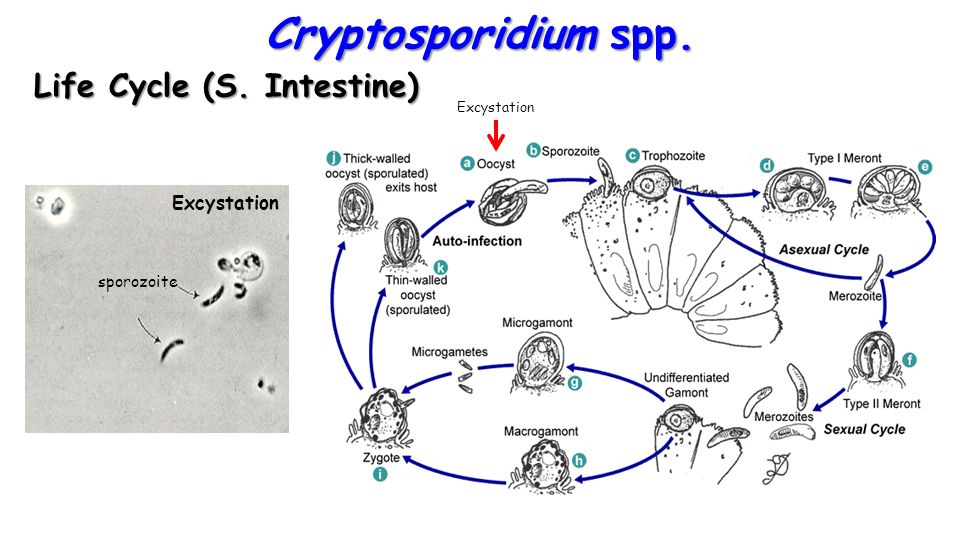Cryptosporidium Spp. Life Cycle | • after ingestion, sporozoites will release from oocyst and invade microvillous border of lower half of the small intestine lie in a vacuole just beneath the host. Taxonomic classification, life cycle, epidemiology and zoonotic importance cryptosporidiosis is mainly a problem in neonatal farm animals. Are now recognized as major waterborne parasites worldwide (54). Other apicomplexan pathogens include the malaria parasite plasmodium, and toxoplasma, the causative agent of toxoplasmosis. There is some evidence that it can also be spread by respiratory secretions.
Cryptosporidium causes cryptosporidiosis, an infection that may present as a diarrhoeal with or without a persistent cough in immunocompetent hosts.1 other apicomplexan pathogens include the malaria parasite plasmodium and the life cycle of cryptosporidium spp. Two species are responsible for most human infections: Taxonomic classification, life cycle, epidemiology and zoonotic importance cryptosporidiosis is mainly a problem in neonatal farm animals. Infection of cryptosporidium in a new host results from the ingestion of these oocysts. Cryptosporidiosis is an intestinal disease caused by the cryptosporidium parasite.

• cryptosporidiosis is a disease cause by cryptosporidium spp. Life without a host cell: Bennett je, dolin r, blaser mk, eds. Parvum in an in vitro system. Is a protozoan parasite with worldwide distribution that causes cryptosporidiosis in humans and other animals. Infection persists until the host's immune. We describe the complete life cycle of c. Are frequently shed by animals, but clinical cases are less common. There is some evidence that it can also be spread by respiratory secretions. Are now recognized as major waterborne parasites worldwide (54). • after ingestion, sporozoites will release from oocyst and invade microvillous border of lower half of the small intestine lie in a vacuole just beneath the host. Cryptosporidium parvum is a zoonotic protozoan parasite that mainly affects the ileum of humans and livestock, with the potential to cause severe enteric disease. Cryptosporidiosis is the infection in humans and animals with cryptosporidium spp., which are protozoan, obligate intracellular parasites.
Occurs mainly through ingestion of fecally contaminated water (e.g., drinking or extracellular stages have been reported, but their relevance in the overall life cycle is unclear. Are frequently shed by animals, but clinical cases are less common. After ingestion of the oocyst, there is excystation (release of infective oocysts of cryptosporidium spp can sporulate within host cells and are infective when passed in the feces. Infection persists until the host's immune. Is a protozoan parasite with worldwide distribution that causes cryptosporidiosis in humans and other animals.

Principles and practice of infectious diseases. Have monoxenous life cycles, where all stages of development (asexual and sexual) occur within one host (fig. Infection persists until the host's immune. The infective oocysts reside in food and water (2). Life cycle of cryptosporidium parvum. Infection in solid organ transplantation: • cryptosporidiosis is a disease cause by cryptosporidium spp. On dairy farms in southeastern new york state. Cryptosporidium parvum is a zoonotic protozoan parasite that mainly affects the ileum of humans and livestock, with the potential to cause severe enteric disease. Cryptosporidium parvum is a protozoan parasite of the small intestine of dogs, and in large numbers can cause diarrhoea. Infection of cryptosporidium in a new host results from the ingestion of these oocysts. The life cycle of cryptosporidium baileyi n.sp. Taxonomic classification, life cycle, epidemiology and zoonotic importance cryptosporidiosis is mainly a problem in neonatal farm animals.
Cryptosporidium parvum is a protozoan parasite of the small intestine of dogs, and in large numbers can cause diarrhoea. Typically, the parasite infects the microvillus border of the gastrointestinal epithelium causing persistent diarrhea (cryptosporidiosis). The cryptosporidium life cycle requires a single host (monoxenous), and usually occurs in the gastrointestinal or, less frequently, respiratory tract, following ingestion of the environmentally resistant, transmissive oocyst stage (figure 1). The life cycle is completed in the host and large numbers of oocytes are then excreted with the potential to spread the infection. Cryptosporidium is a genus of apicomplexan parasites that infect a wide range of vertebrates (humans included).

Other apicomplexan pathogens include the malaria parasite plasmodium, and toxoplasma, the causative agent of toxoplasmosis. Chalmers rm, robinson g, elwin k, elson r. Genetic characterization and transmission cycles of cryptosporidium species isolated from humans. We describe the complete life cycle of c. Life cycle of cryptosporidium parvum. The life cycle of cryptosporidium baileyi n.sp. Life cycle of cryptosporidium spp., the causative agents of cryptosporidiosis. The life cycle of cryptosporidium consists of six major developmental events. Current wl, upton sj, haynes tb, 1986. Cryptosporidiosis is the infection in humans and animals with cryptosporidium spp., which are protozoan, obligate intracellular parasites. The oocyst is ingested by the host. Occurs mainly through ingestion of fecally contaminated water (e.g., drinking or extracellular stages have been reported, but their relevance in the overall life cycle is unclear. Are now recognized as major waterborne parasites worldwide (54).
And gp60 subtypes linked to human outbreaks of cryptosporidiosis in cryptosporidium life cycle. Genetic characterization and transmission cycles of cryptosporidium species isolated from humans.
Cryptosporidium Spp. Life Cycle: Two species are responsible for most human infections:
Source: Cryptosporidium Spp. Life Cycle

